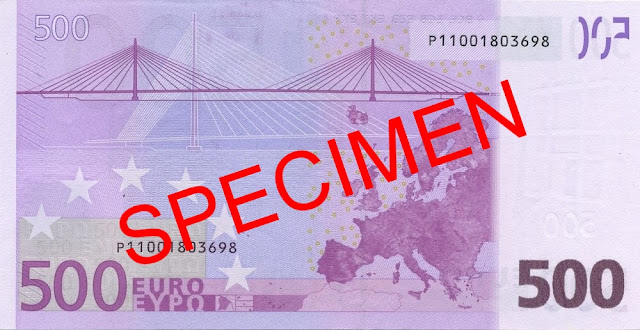Obverse: Modern architecture 20th century.
Reverse: Suspension bridge and map of Europe.
Watermark: Modern windows, "500".
Signature of second President of the European Central Bank - Wim Duisenberg.
serial # prefix: P - Netherlands.
The five hundred euro note (€500) is the highest-value euro banknote and has been used since the introduction of the euro (in its cash form) in 2002. The note is used in the 23 countries which have the euro as their sole currency (with 22 legally adopting it), with a population of about 338 million.
The five hundred euro note measures at 160 millimetres (6.3 in) × 82 millimetres (3.2 in) with a purple colour scheme. All bank notes depict bridges and arches/doorways in a different historical European style; the five hundred euro note shows Modern architecture (around the 20th century). Although Robert Kalina's original designs were intended to show real monuments, for political reasons the bridge and art are merely hypothetical examples of the architectural era. Nevertheless, the featured bridge is highly similar to Guadiana International Bridge.
Like all euro notes, it contains the denomination, the EU flag, the signature of the president of the ECB and the initials of said bank in different EU languages, a depiction of EU territories overseas, the stars from the EU flag and twelve security features as listed below.
The five hundred euro note contains several complex security features such as watermarks, invisible ink, holograms and microprinting that make counterfeiting very difficult. Initially, the high denomination notes were introduced very rapidly so that in the first 7 years (up to December 2008) there were 530,064,413 five hundred euro banknotes in circulation. Subsequently, the rate of increase was radically slowed. In January 2016 there were 611,833,416 in circulation.
The European Central Bank announced on 4 May 2016 that it would phase out the 500 euro note by the end of 2018. “Authorities increasingly suspect that they (€500 notes) are being used for illegal purposes, an argument that we can no longer ignore,” according to a high-ranking bank official, Benoît Cœuré.
Euro banknotes
2002 Series
Banknotes of the euro, the currency of the Eurozone, have been in circulation since the first series was issued in 2002. They are issued by the national central banks of the Eurosystem or the European Central Bank. In 1999 the euro was introduced virtually, and in 2002 notes and coins began to circulate. The euro rapidly took over from the former national currencies and slowly expanded around the European Union.
Denominations of the notes range from €5 to €500 and, unlike euro coins, the design is identical across the whole of the Eurozone, although they are issued and printed in various member states. The euro banknotes are pure cotton fibre, which improves their durability as well as giving the banknotes a distinctive feel. They measure from 120 by 62 millimetres (4.7 in × 2.4 in) to 160 by 82 millimetres (6.3 in × 3.2 in) and have a variety of colour schemes. The euro notes contain many complex security features such as watermarks, invisible ink, holograms and microprinting that document their authenticity. While euro coins have a national side indicating the country of issue (although not necessarily of minting), euro notes lack this. Instead, this information is shown by the first character of each note's serial number.
According to European Central Bank estimates, in August 2016, there were approximately 19,417,000,000 banknotes in circulation around the Eurozone, worth approximately €1.1 trillion. On 8 November 2012, the European Central Bank announced that the first series of notes would be replaced by the Europa series, starting with the 5 euro note on 2 May 2013.
Europa series of euro banknotes
2013-2015 Issue
Currency Exchange Rates for Euro Member Countries
Old European Currencies
Old European Currencies

